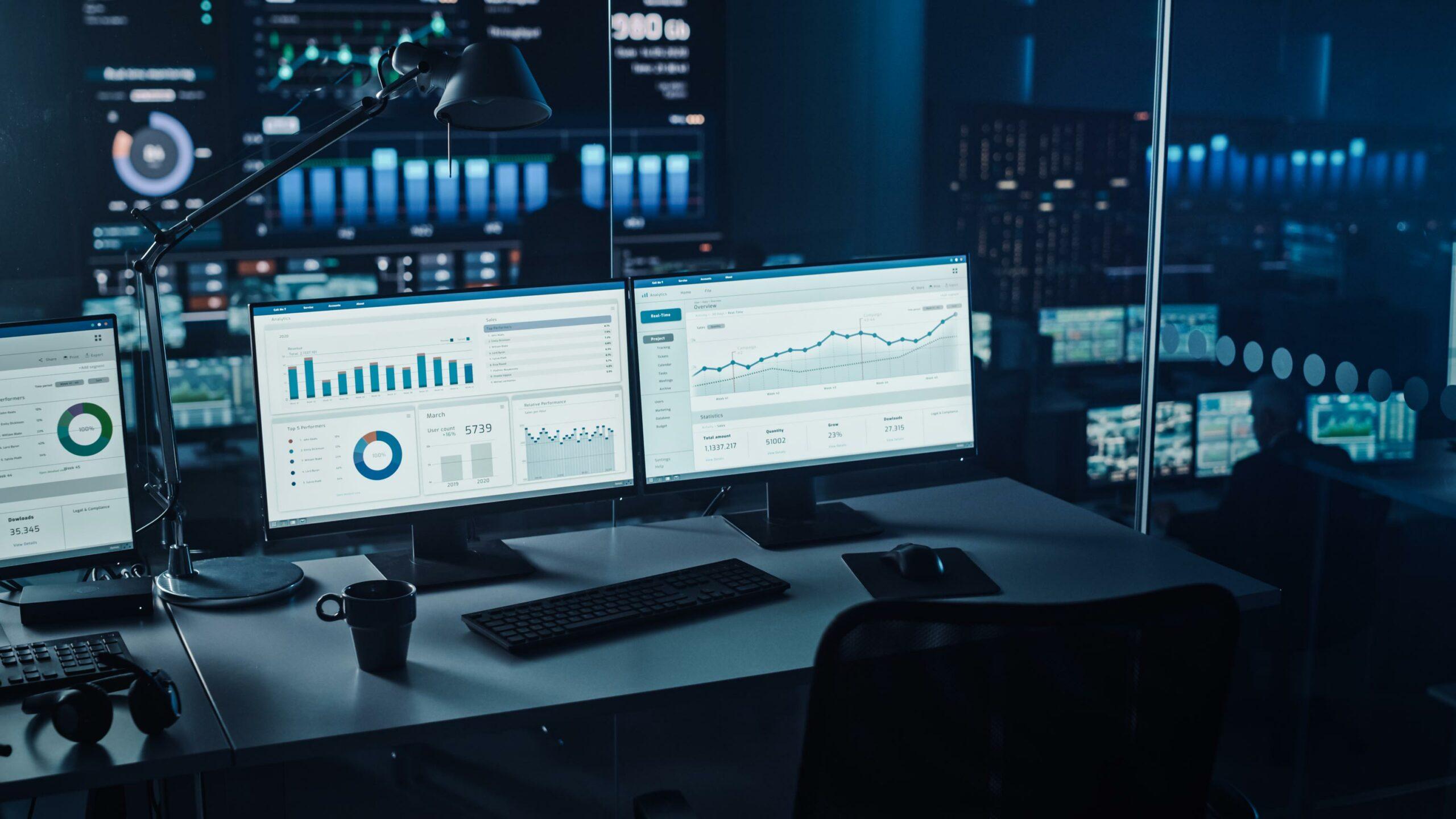IT monitoring is the process of keeping track of how your company’s technology systems are performing. The main goal of IT monitoring is to ensure your critical applications and services are available for employees and customers. Some key things monitoring does include:
- Detecting issues quickly before they cause major problems
- Reducing downtime of websites and applications
- Ensuring systems meet performance standards
- Maintaining security and regulatory compliance
Whether you have servers on-premises or in the cloud, IT monitoring gives the visibility needed to understand how your infrastructure and software are running. It provides metrics on key areas like response times, traffic levels, errors, and system usage. With the right monitoring tools, your team can proactively address issues rather than waiting for complaints.
This guide will explain IT monitoring, why it’s important for businesses, and how to build an effective monitoring strategy using popular tools. We aim to help you keep your critical IT systems running smoothly.
What is Being Monitored?
With so many moving parts that keep your technology humming, it’s important to see what exactly requires monitoring. There are a few key areas IT teams tend to observe:
Infrastructure
Your servers, storage, network switches, and other hardware that power applications are crucial to watch. Metrics like CPU usage, memory levels, and disk capacity can alert you to potential bottlenecks or failures before they impact users.
Applications
The software your business relies on each day demands attention, too. Application response times, error rates, and resource consumption are good to have on your radar. Any sign of slowing or unstable performance warrants investigation.
Databases
As the keepers of critical company data, your databases, like Microsoft SQL Server, require monitoring of connections, query times, and storage consumption. It helps ensure smooth operations and protects against outages.

Networks
Monitor bandwidth usage, packet loss rates, and interface status with everyone and everything connected. Network monitoring prevents issues like slow internal or public-facing sites.
User Experience
Using synthetic tests and real user monitoring, you gain insight into how your digital assets behave for customers. Page load speeds, geographic distribution, and crash rates are illuminating.
Security
Logs, alerts, and threat intelligence gathering through monitoring defend you against hackers and data breaches. It’s an important line of defense for your operations.
Cloud Resources
Whether the infrastructure is on-premise or cloud-based, like AWS, monitoring spending, capacity, and service health provides budget oversight and performance assurance.
The tools and metrics may vary depending on your specific environment, but ensuring visibility across all these domains is key to maintaining control of your IT realm. Proper monitoring prevents small problems from multiplying into big headaches and keeps your operations running at peak performance.
Why Monitor IT Systems?
By now, you understand the various facets of your IT environment that demand monitoring, but why is it so crucial? There are several compelling reasons to invest the time and resources into keeping close tabs on your systems.
Reduce Downtime
With proactive monitoring, you can address issues early before they escalate. It minimizes disruptions to productivity and the user experience.
Improve Performance
Bottlenecks, errors, and other inefficiencies are easier to spot and remedy when you have metrics over time. Faster, smoother operations result.
Enhance Security
Threats like malware, hackers, and vulnerabilities are countered with constant log inspection, anomaly detection, and incident response readiness.
Ensure Compliance
For regulated industries, monitoring supports audits by proving systems meet privacy, security, and uptime standards. Non-compliance can mean costly penalties.
Informed Decision Making
Performance indicators and usage insights illuminate investment priorities by revealing which systems are most critical or nearing capacity limits. It optimizes budgets.
Drive Revenue
When applications and customer touchpoints perform well, it directly boosts sales and retention. Monitoring underpins digital initiatives that fuel business growth.
Support Users
Internal end users are more productive, and external customers have better experiences, thanks to timely issue resolution that monitoring facilitates.
The business value of a reliable, high-performing IT infrastructure should be clear. With monitoring providing full visibility, your operations run more smoothly while reducing risks to operations and compliance. The returns make a compelling case for the importance of monitoring.
The Monitoring Process
Now that we’ve covered what and why, let’s explore how monitoring works. Most IT teams follow a standard routine to keep systems performing as expected.
- Planning: Deciding what to monitor, metrics to track, and threshold levels involves research. It defines your monitoring strategy.
- Deployment: Agents and sensors must be installed to collect system data without disrupting operations. Configuration is key.
- Collection: Metrics specified in planning are continuously gathered from infrastructure, apps, networks, and more using APIs or agent reporting.
- Analysis: Monitoring platforms process incoming data, flagging any variances from normal baselines. Correlations investigate interdependencies.
- Alerting: Email, text, or collaboration tools notify teams when KPIs breach thresholds set during planning. Context is provided.
- Triage: Based on alert severity, qualified staff assess to determine the root cause, potential impact, and best resolution approach.
- Repair: When issues are identified, changes like capacity increases, configuration tweaks, or software updates to restore performance may be required.
- Review: Regular evaluation of monitoring configurations, response workflows, and collected metrics helps hone strategies over time based on evolving needs.
Properly executing each step is vital as it drives the entire monitoring lifecycle. Automation through AIOps enhances traditionally manual tasks for improved efficiency as volumes increase. Ultimately, the goal is to keep an eye on everything to minimize disruptions to your operations.
Monitoring Tools to Consider
With so many monitoring options, deciding which tools are best for your needs can feel daunting. However, focusing on key factors makes the selection process more manageable.
Infrastructure Monitoring
For physical and virtual servers, networks, and hardware, tried-and-true options include Nagios, Zabbix, Datadog, and SolarWinds. They deliver deep system insights.
Application Performance
When apps are your priority, consider AppDynamics, New Relic, or Dynatrace for code-level visibility into slowdowns and outages and their root causes.
Network Monitoring
Specialized tools like SolarWinds, Cisco, and ManageEngine track network devices, traffic trends, latency, and bottlenecks at the packet level for smooth connectivity.
Cloud Monitoring
Multi-cloud usage demands solutions like Datadog, Dynatrace, and AWS CloudWatch, providing a unified view of resources in public clouds and private data centers from a single pane of glass.
Integration Capabilities
Native integrations with common ITSM and security tools save time and effort. They also consolidate views for improved efficiency.
Visualization Quality
Easy-to-read visuals like customizable dashboards help you and others quickly understand complex performance landscapes.
Alert Options
Flexible alerting through email, SMS, collaboration apps, or on-call scheduling ensures the right people are informed of issues immediately for fast remediation.
With so many options, testing various free trials can help you choose monitoring tools tailored to your IT environment, budget, and support requirements. Comprehensive visibility is key to keeping an eye on all systems.
Current Trends in IT Monitoring
Several trends are reshaping the monitoring landscape that organizations should be aware of.

The Rise of AIOps
Leveraging ML and AI, AIOps automate mundane tasks like event correlation to free up teams for higher-value work. It also improves anomaly detection over traditional rules.
Given the proliferation of monitoring tools, the market is consolidating around unified platforms that provide a cohesive view across networks, servers, and business apps on-prem or in the cloud. Fewer vendors mean lower costs and better coordination.
Focus on User Experience
With digital transformation, monitoring has also expanded to track key user experience metrics like page load speeds, crash rates, and geographic distribution to ensure optimal customer journeys.
Proactive Problem Prevention
Leveraging massive data sets, predictive analytics can identify issues before they impact operations – changing monitoring from reactive to proactive. Problems are solved before users notice.
Security and Monitoring Convergence
As cybersecurity has become critical, these two domains are integrating further. Security information and event management (SIEM) platforms now monitor for threats in addition to performance.
Open Source Adoption
Open-source monitoring tools like Prometheus and Grafana are gaining popularity due to their low costs and extensibility. Support communities help maximize their capabilities.
Staying atop emerging developments like these helps ensure your monitoring strategy aligns with where the industry is headed next. Proper evaluation is key to deriving ongoing value.
Tips for Effective Monitoring
Review what’s being tracked, the metrics used, and alert thresholds. Ensure these still align with your environment and needs. What worked last year may no longer apply.
- Leverage Automation and AI: Use AIOps capabilities to automate repetitive tasks like event correlation. It frees up teams for more strategic work while improving anomaly detection rates.
- Consolidate Tools and Data: Unified platforms that provide a single view reduce alert fatigue and tool sprawl. Integrate data sources for enhanced root cause analysis across silos.
- Train Response Teams: Ensure your on-call staff are well-versed in triaging alerts and resolving issues through simulation exercises. It speeds up incident resolution times.
- Reduce Noise Through Context: Provide responders with historical metrics, logs, and topology data so they understand normal system behavior and can identify true anomalies quickly.
- Involve Stakeholders: Include business teams in defining SLAs and KPIs to monitor. Their input leads to tracking the right metrics aligned with priorities versus generic IT-focused ones.
- Test and Validate: Regularly run tests to validate that your monitoring configuration accurately detects issues through controlled injections. It confirms everything is working as intended to catch real problems.
- Leverage Community Expertise: Contribute to and engage with open-source monitoring communities to learn best practices and new techniques and help improve solutions for all. Your feedback enhances the tools.
With these tips at the top of your mind, you can derive maximum value from your monitoring investment and stay ahead of performance issues to keep business systems running seamlessly. Proactive management is key.
Outsourcing to ZZ Servers
To establish an effective IT monitoring strategy without needing more in-house resources or expertise, consider partnering with an experienced managed services provider like ZZ Servers. For over 17 years, ZZ Servers has been helping small and medium-sized businesses implement customized monitoring and security solutions tailored to their unique needs. Their certified professionals can comprehensively assess your environment, recommend the right tools, set up personalized alerts and dashboards, and provide 24/7 monitoring support. Outsourcing to ZZ Servers allows you to gain visibility into your critical systems without overextending your existing staff. To learn more about how ZZ Servers can help you proactively manage your IT infrastructure for improved performance, compliance, and peace of mind, call 800-796-3574 today.
Conclusion
IT monitoring provides metrics on infrastructure, applications, databases, networks, and security to ensure optimal performance. It helps reduce downtime, improve safety and compliance, and support better decision-making.
Monitoring involves planning, deployment, collection, analysis, alerting, and review. Tools that provide comprehensive tracking of on-prem and cloud environments should be considered. Current trends drive consolidation, AIOps adoption, and a proactive, predictive approach to issue prevention.
Monitoring best practices around automation, consolidated views, and response optimization can help keep business systems running smoothly.
Frequently Asked Questions
What are some common IT monitoring metrics?
Key metrics include CPU usage, memory levels, response times, error rates, bandwidth usage, database query performance, and uptime percentages. These provide insights into how efficiently infrastructure, applications, networks, and databases operate.
How do I select the right monitoring tools for my organization?
Consider your monitoring needs, budget, and technical skills. Evaluate options with free trials to see which provide the required visibility for your specific environments in an easy-to-use package. Look for tools with customization, flexible alerting, and integrations to streamline workflows.
What are the benefits of proactive monitoring vs reactive?
Proactive monitoring leverages analytics to identify issues before they impact users. It minimizes downtime and disruption compared to waiting for problems to occur and complaints. Aggressive methods improve customer experience while reducing long-term costs.
What monitoring best practices can help reduce alert fatigue?
Leverage context, prioritize alerts by severity, tune thresholds appropriately, automate routine tasks, and consolidate tools to remove noise. Regularly review configurations and involve operations teams to ensure monitoring stays optimized over time as your needs evolve.
How is AI/ML changing the IT monitoring landscape?
AIOps is automating repetitive tasks to boost efficiency. Machine learning enhances anomaly detection capabilities and drives predictive analytics for proactive issue prevention. AI also powers new consolidated, intelligent monitoring platforms for improved visibility and streamlined management.



